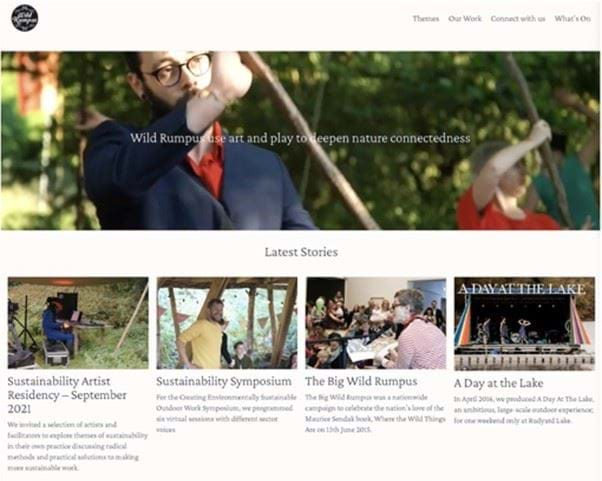Wild Rumpus: A UX and sustainability audit
Nexer helped Wild Rumpus to make it's web presence more appealing to international artists and collaborators. We conducted a UX review and sustainability audit and offered recommendations to make the new site both greener and more user-centred.
Who are Wild Rumpus?
Wild Rumpus is a social enterprise running a programme of projects such as festivals, large-scale events, creative interventions, meaningful partnerships and sector development work. The organisation aims to use arts and culture to raise awareness and help people gain new perspectives on biodiversity and the impact of its loss. Wild Rumpus work internationally from their exploratory creation space based in the English woodland.
Earlier last year, our teams gathered at Wild Rumpus’ wonderful whirligig woods to kick off the year and focus on ways of improving sustainability and reducing the impact of digital. Since then, we’ve developed our sustainability strategy and are helping clients make more sustainable choices when it comes to their digital estates
The project
Wild Rumpus wanted Nexer Digital’s support to make their online presence more appealing for international collaborators and clients, whilst also reviewing the accessibility and sustainability of the website. We carried out an expert UX review as well as a SEO and sustainability audit. Here’s what we did:
User-centred UX review
Wild Rumpus were designing a new website and wanted Nexer’s expertise to ensure it worked well for the audiences they wanted to attract. Though their work is aimed mostly at families, Wild Rumpus wanted this website primarily to show potential collaborators, artists, makers and partners what they do to help forge positive new relationships. They were also interested in looking beyond the UK for potential partnerships, having collaborated internationally in the past.
We worked with the Wild Rumpus team to understand more about their audiences before looking at their progress with website design. We then identified some opportunities to strengthen the user journeys for three key types of audience. An existing partner also gave us some excellent insights into what potential collaborators might be looking for. They helped us to understand how Wild Rumpus’ core values around the power of art, engaging families with nature, and sustainability were important messages to reach audiences.
As well as our recommendations to fine-tune the user journeys, we also offered more general suggestions to improve the user experience. Key pointers focussed on good signposting from the home page and improving onward journeys to suggest next steps for visitors. We also highlighted some good practice around key page elements such as buttons and navigation menus.
Next, we looked at how the site performed in terms of accessibility. We talked Wild Rumpus through the parts of the site that wouldn’t perform well for those with visual impairments or those using screen readers and demonstrated how to solve these issues and audit for themselves in future.
Our team presented Wild Rumpus with a set of recommendations to help optimise their site, increase impact among their target audience and create a set of learnings to apply to other customer-facing websites within their digital estate.

Sustainability audit
In addition to the UX review, our team also conducted an audit to benchmark the sustainability metrics of the current Wild Rumpus site and offer some suggestions for ways to reduce the carbon intensity of key web pages. Using various tools, we audited six key pages. We focussed on the home pages, and then the next top consecutive pages based on traffic percentage according to SEMrush, a leading SEO tool.
The data we collected showed that the pages sampled carried an average carbon weighting of 3.3g per page view. And although they were on average around 37.7% greener than other websites tested on the same tools, we identified some areas for improvement to increase these sustainability scores.
Our recommendations focussed on a range of topics, from the technical performance of webpages to presenting content maximising efficiency and accessibility for users. We also made suggestions based on reducing the demand on users’ devices, including sharing compressing media files and implementing lazy loading across web pages. This also has the benefit of reducing the bandwidth used when using mobile data and browsing outside WiFi networks.
These suggestions aim to reduce blockers and improve the journey for users, improving page load performance as an overall result. They would reduce demand on the Wild Rumpus site resources, ultimately improving its carbon footprint as a result.
The results
This set of recommendations offered a good basis for Wild Rumpus to develop its new website with a user-centred and sustainable approach. Helping Wild Rumpus identify their audiences and strengthen user journeys will allow the organisation to reach international collaborators and partners they aim to connect with. The suggestions we made around increasing efficiency and reducing the weight of web pages will help make the new site greener, less carbon-intensive and more efficient for users.
Get in touch
If you would like to work with our team on your project, email us at hello@nexerdigital.com or call one of our offices: Macclesfield on +44 (0)1625 427718, or Cambridge on +44 (0)1223 626629
